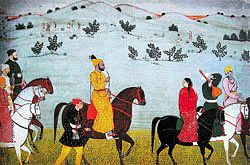Marvels in miniature

From the 17th to mid-19th centuries, artists of the Himalayan foothills or pahari region produced exquisite miniature paintings, which are a vital part of India’s artistic heritage.
Foremost among them was Nainsukh, whom distinguished art historian Prof B N Goswamy ranks among India’s finest miniature painters. Working in the 18th century, Nainsukh left behind a treasure trove of portraits, court scenes, hunting scenes and glimpses of daily life. In the 100-odd surviving paintings and sketches attributed to him, we see a deceptively simple world rife with complex subtleties. With an incredibly light yet masterly touch, Nainsukh’s paintings breathe life into magical and intensely human moments from times long gone.
Nainsukh was born in Guler, a tranquil place in the hills, and created many of his paintings there as well as in Jasrota. He painted in a fresh, realistic and ethereal style, marking a change from the earlier heritage of rich, bold colours, robust human figures and breath-taking stylised language of art. Nainsukh’s work is marked not by emphatic accents, but by soft, delicate tones.
They appear simple at first glance, but a closer look reveals subtle nuances brought out through skillfully executed precise lines. Nainsukh captured the beauty of the people and their emotions, and the verdant hills where they lived.
This came to be known as the Guler style, and it would have been inspired by the naturalistic style of Mughal paintings of the time. Delivering the inaugural lecture for Tasveer Foundation’s lecture series,Prof Goswamy averred that among all the painters in the hills, Nainsukh interpreted, incorporated and single-handedly changed the course of pahari miniature paintings. Even when Nainsukh copied Mughal paintings, he added his own interpretations and refinements.
It isn’t easy to trace an individual painter through the history of Indian art. Many of them remain anonymous, leaving few traces apart from their surviving work. Determined to learn more about the man behind the fascinating paintings, Prof Goswamy painstakingly investigated leads resulting in a unique book on an individual old painter.
In Nainsukh’s times the pahari region, comprising of modern-day Himachal Pradesh, some adjoining areas of the Punjab, Jammu and Garhwal, was divided into small kingdoms ruled by Rajput princes who were often at war. Several of these rulers promoted the arts, and the region was a hub of great artistic activity. Nainsukh found patronage from the rulers of Jasrota, a small and relatively poor kingdom near Jammu, with Raja Zorawar Singh and his son Raja Balwant Singh. These minor princes loved the arts more than warfare and statecraft, and Nainsukh’s miniatures document their lives with sensitivity and grace.
From his paintings, one can infer the symbiotic relationship Nainsukh enjoyed with his patrons. Balwant Singh is shown as a hunter, a warrior and a statesman in court. An unusual painting shows a huge white palace with Balwant Singh a tiny speck alone on the terrace admiring rain-bearing clouds. Intimate moments of Balwant Singh’s daily life, such as having his beard trimmed, bring us close to the subject as a human being. Through the years, Nainsukh faithfully captured the deepening lines on his patron’s face.
In old age, Balwant Singh appears as a nobleman fallen in hard times, with a lone faithful servant in attendance. Nainsukh drew many portraits of Balwant Singh, some of which also included himself. One of these shows Balwant Singh appreciatively viewing a painting presented by Nainsukh. Balwant Singh appreciated music, and some paintings show him surrounded by court musicians.
Other painters would have concentrated on portraying the raja, relegating the musicians and courtiers to the role of bit players. But Nainsukh’s minor characters are suffused with deep humanity of observation. Each musician comes across as a unique individual, with fingers delicately poised, bodies and facial expressions showing their effort and dedication to create lovely melodies. A minister who betrayed the raja is painted with an ominously shrewd expression. In another work, a bent crone comes to life with masterly strokes, as she whispers dark intrigues into the ear of a perturbed princess.
Nainsukh also painted scenes from ordinary life. A wonderful study shows a group of simple villagers huddled around a fire on a winter night. The play of light, shadows and expressions is rare in Indian art. Another lovely painting shows a herd of elephants bathing in a forest. Nainsukh also created imaginary compositions, one of which shows mountains, palaces, an entire world contained within a mysterious boat. Does it illustrate a folktale or a metaphor for the human condition? One can only guess its true significance.
Glimpses of Nainsukh, the man, fleetingly appear and vanish like the flicker of fireflies in the night. Prof Goswami’s research led him to ancient pothis or manuscripts maintained by pandits in Haridwar, which contain records and genealogies of all families of the region for centuries. While leafing through the sepia scrolls, he miraculously found entire pages written by Nainsukh himself in beautiful script.
The artist wrote the date and his purpose of visiting Haridwar — to immerse the ashes of his departed patron, Raja Balwant Singh. In a corner of the page, he decided to add a tiny yet exquisite sketch appropriate for the occasion. With masterly strokes, he depicted Bhagirath supplicating before Lord Shiva and Parvati to bring the Ganga to earth. While Lord Shiva gently nods his assent, Parvati appears wonderstruck. For an instant, Nainsukh comes suddenly to life as a man mourning a dear patron, with whom he had shared many intimate moments of his life.
Deccan Herald is on WhatsApp Channels| Join now for Breaking News & Editor's Picks